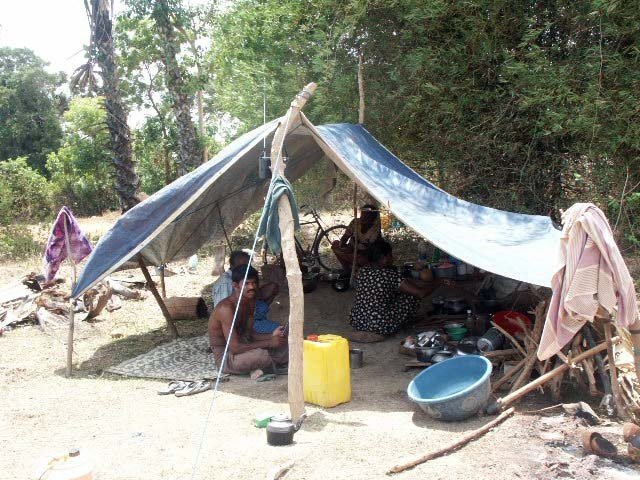 |
| An Inuit Igloo - traditional snow shelter. (Source: www.icrecreamnation.org, 2013) |
In kicking off the new BushScience series I thought I’d sneak this topic in before winter leaves us entirely. The science of snow keeping you warm can seem counter intuitive but in reality is very simple. In the UK we rarely have enough snow to enable the practice of making snow shelters, with the possible exception of the Scottish Highlands, but they are nevertheless a well known concept, even if only from children's programmes. However, in other parts of the world, most notably Arctic regions with indigenous groups such as the Inuit, snow shelters of one sort or another are still common. Most famous has to be the igloo, those domed structures built of snow blocks.
I am sure I am not alone in having heard people commenting on how they ‘can’t understand the point of these shelters, because it must be freezing in there’ or statements to that effect. Of course these people are right: it is freezing in snow shelters - but all things are relative. In the UK or other temperate climates our idea of a snowy skirmish, maybe once or twice a year and most likely at temperatures between 2oC and -5oC (36oF - 23oF), ends in a retreat to a heated home at around 20oC (68oF). With this concept of cold, then freezing in the real sense (0oC or 32oF) does sound pretty cold. But snow shelters are for regions with persistent snow not the odd flurry, where the temperatures can drop far lower, maybe -30oC (-22oF) or less. In these circumstances coming in to a shelter that offers freezing temperatures, or even slightly lower is a much ‘warmer’ proposition, representing a similar temperature difference as going from a temperate winters day to a warm house.
 |
| A close up of some snow flakes (Source: Flickr user LadyDragonflyCC, 2013) |
Lets consider then how this works, it really is very simple. We humans have devised essentially just two methods to keep warm - an active source of heat, with fire being the most obvious example, and insulation, a more passive method. Snow acts as an insulator and works in exactly the same way as many other insulators, by trapping air. As we all know snow is essentially fine ice crystals, when it lays a large proportion of the volume of the snow is air - think of how much compacting (or air removal) you have to do to get a decent snowball. The air trapped within the snow is less influenced by outside air temperature because it has no direct contact with it and therefore tends to be fairly constant, at or around the temperature of the snow itself. When this air-filled snow is used in the construction of shelters it breaks the direct link between external and internal air and slows or prevents entirely the equalisation of air temperature by heat conduction. (For a slightly more scientific description of the properties of snow as an insulator try one of these: https://nsidc.org/cryosphere/snow/index.html , http://www.inscc.utah.edu/~campbell/snowdynamics/reading/Pomeroy.pdf )
Other insulators that work on this principle include warm clothes, double glazing, duvets, sleeping bags, loft insulation and many others. None of them in their own right provide a heat source, but they all retain air, either in a distinct layer or in lots of little pockets. With the introduction of a heat source, in the case of clothing or blankets a person, or in the case of double glazing or loft insulation some source of domestic heating, this trapped layer of air prevents the warmth of the air being conducted away by disrupting its direct link with external, usually lower temperatures.
 |
| An Inuit whale blubber lamp, known as a 'quilliq'. (Source: Brendan Griebel, 2012) |
A small heat source inside a snow shelter, these days something like a small gas stove but more traditionally in areas where these sort of shelters are used a seal fat or whale blubber lamp, will slowly warm, and maintain, the temperature within a snow shelter, aided by the body heat of the occupants. When correctly equipped with suitable clothes and appropriate sleeping arrangements - remember the adage: there’s ‘No such thing as bad weather only the wrong clothes’ - these shelters can provide a warm (relatively, remember) retreat from the crippling temperatures outside. A further advantage, which cannot be under-estimated, is the shelter from the wind provided by such a structure. The wind chill factor of the gale force winds which frequent Arctic areas can make already uncomfortably low temperatures unsurvivable - a wind-break is worth its weight in gold, let alone snow! A few simple modifications, such as a cold sink (essentially a whole in the floor) and raised bed platforms, keep the occupants higher in the interior - warm air rises - making the most of the ‘warm’ temperatures. If you do fancy having a go at making a snow shelter follow this link for a chapter from the ‘Field manual for the U.S. Antarctic program’ on making snow shelters - but good luck on finding snow that will work!
As a round up then: snow doesn't keep you warm, but it can help you keep ‘warmer’ than you might otherwise be!
Richard


















.jpg)



